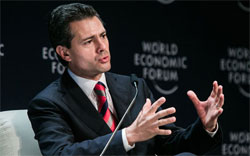Only a handful of countries submitted their climate targets to the UN by the March 31 deadline, and Mexico and Russia are among them.
The others are the US, European Union, Norway (same as EU) and Switzerland (cut emissions 50% from 1990 levels by 2030, and 70-85% by 2050). All commitments are posted here as they come in.
Mexico’s goals:
- cut greenhouse gas emissions (GHG) 22% by 2030
- cut black carbon emissions 51% by 2030
- reduce emissions intensity (amount of carbon emitted per unit of GDP) 40% by 2030.
When the targets for GHG and black carbon are combined, the total cuts add up to 25%. The statement says Mexico would raise the goal up to 40% depending on what ends up in a global agreement – whether it addresses an international carbon price, technical cooperation, access to low-cost financing and technology transfer, "all at a scale commensurate to the challenge of global climate change."
Among the many adaptation strategies, these stand out:
- Reach Zero deforestation by 2030
- Reforest watersheds
- Preserve and restore ecosystems to increase ecological connectivity of all protected areas
- Substantially increase programs that protect priority species from climate change.
- preserve and restore coastal and marine ecosystems such as coral reefs, mangroves, sea grass and dunes.
- Guarantee water management for all stakeholders, including ecosystems.
Mexico passed national legislation on climate change in 2012.
US-Mexico Cooperate on Climate
Afterwards, President Obama and President Nieto released a joint statement, reaffirming their commitment to working together on climate change, calling it "one of the greatest threats facing humanity." The US and Mexico will "seize every opportunity to harmonize their efforts and policies towards their common climate goals."

To that end, the two countries are launching a "high level bilateral clean energy and climate policy task force to deepen policy and regulatory coordination" in areas such as renewable energy, grid modernization, appliance standards, energy efficiency, and more fuel efficient automobile fleets.
They will also work together on air quality, climate policies, such as harmonizing standards for diesel emissions, and on programs that address carbon forcers – HFCs and black carbon. Lastly, cooperation will also extend to climate modeling, weather forecasting and early alert systems.
Chaired by Energy Secretaries from both countries, the first meeting takes place this spring.
Last year, California signed its own cooperative environmental agreement with Mexico that ranges from attacking wildfires and improving air quality to carbon pricing and expanding the electric vehicle market.
Russia’s Pledge
Russia pledged to cut GHG emissions up to 30% from 1990 levels, subject to conditions.
It says, "limiting anthropogenic [man-made] greenhouse gases in Russia to 70-75% of 1990 levels by the year 2030 might be a long-term indicator." That is, if it can include standing forests as part of the emissions cuts.
While Russia sees this as possible, it won’t make a final decision until all major emitters have pledged and how the final agreement turns out.
Russia ranks #5 on GHG emissions (producing 5% of world emissions), after China, the US, EU, and India, according to the World Resources Institute. Only the US and EU have submitted pledges so far.
While people are pleasantly surprised that Russia was among the initial group of countries to submit its pledge, the ambiguous statement leaves many confused, especially given its history.
Read more about Russia:
